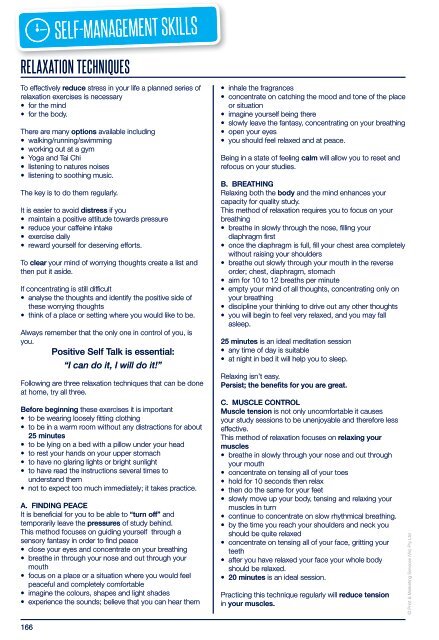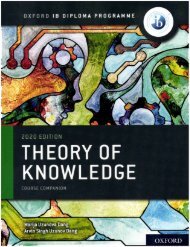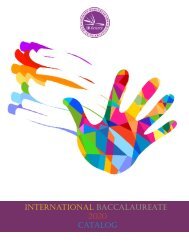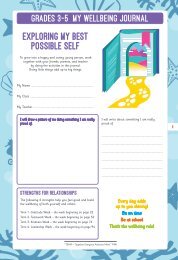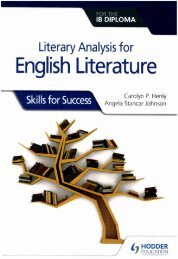2019-20 N. American Planner_DP Sample
Create successful ePaper yourself
Turn your PDF publications into a flip-book with our unique Google optimized e-Paper software.
SELF-MANAGEMENT SKILLS<br />
RELAXATION TECHNIQUES<br />
To effectively reduce stress in your life a planned series of<br />
relaxation exercises is necessary<br />
• for the mind<br />
• for the body.<br />
There are many options available including<br />
• walking/running/swimming<br />
• working out at a gym<br />
• Yoga and Tai Chi<br />
• listening to natures noises<br />
• listening to soothing music.<br />
The key is to do them regularly.<br />
It is easier to avoid distress if you<br />
• maintain a positive attitude towards pressure<br />
• reduce your caffeine intake<br />
• exercise daily<br />
• reward yourself for deserving efforts.<br />
To clear your mind of worrying thoughts create a list and<br />
then put it aside.<br />
If concentrating is still difficult<br />
• analyse the thoughts and identify the positive side of<br />
these worrying thoughts<br />
• think of a place or setting where you would like to be.<br />
Always remember that the only one in control of you, is<br />
you.<br />
Positive Self Talk is essential:<br />
“I can do it, I will do it!”<br />
Following are three relaxation techniques that can be done<br />
at home, try all three.<br />
Before beginning these exercises it is important<br />
• to be wearing loosely fitting clothing<br />
• to be in a warm room without any distractions for about<br />
25 minutes<br />
• to be lying on a bed with a pillow under your head<br />
• to rest your hands on your upper stomach<br />
• to have no glaring lights or bright sunlight<br />
• to have read the instructions several times to<br />
understand them<br />
• not to expect too much immediately; it takes practice.<br />
A. FINDING PEACE<br />
It is beneficial for you to be able to “turn off” and<br />
temporarily leave the pressures of study behind.<br />
This method focuses on guiding yourself through a<br />
sensory fantasy in order to find peace<br />
• close your eyes and concentrate on your breathing<br />
• breathe in through your nose and out through your<br />
mouth<br />
• focus on a place or a situation where you would feel<br />
peaceful and completely comfortable<br />
• imagine the colours, shapes and light shades<br />
• experience the sounds; believe that you can hear them<br />
• inhale the fragrances<br />
• concentrate on catching the mood and tone of the place<br />
or situation<br />
• imagine yourself being there<br />
• slowly leave the fantasy, concentrating on your breathing<br />
• open your eyes<br />
• you should feel relaxed and at peace.<br />
Being in a state of feeling calm will allow you to reset and<br />
refocus on your studies.<br />
B. BREATHING<br />
Relaxing both the body and the mind enhances your<br />
capacity for quality study.<br />
This method of relaxation requires you to focus on your<br />
breathing<br />
• breathe in slowly through the nose, filling your<br />
diaphragm first<br />
• once the diaphragm is full, fill your chest area completely<br />
without raising your shoulders<br />
• breathe out slowly through your mouth in the reverse<br />
order; chest, diaphragm, stomach<br />
• aim for 10 to 12 breaths per minute<br />
• empty your mind of all thoughts, concentrating only on<br />
your breathing<br />
• discipline your thinking to drive out any other thoughts<br />
• you will begin to feel very relaxed, and you may fall<br />
asleep.<br />
25 minutes is an ideal meditation session<br />
• any time of day is suitable<br />
• at night in bed it will help you to sleep.<br />
Relaxing isn’t easy.<br />
Persist; the benefits for you are great.<br />
C. MUSCLE CONTROL<br />
Muscle tension is not only uncomfortable it causes<br />
your study sessions to be unenjoyable and therefore less<br />
effective.<br />
This method of relaxation focuses on relaxing your<br />
muscles<br />
• breathe in slowly through your nose and out through<br />
your mouth<br />
• concentrate on tensing all of your toes<br />
• hold for 10 seconds then relax<br />
• then do the same for your feet<br />
• slowly move up your body, tensing and relaxing your<br />
muscles in turn<br />
• continue to concentrate on slow rhythmical breathing.<br />
• by the time you reach your shoulders and neck you<br />
should be quite relaxed<br />
• concentrate on tensing all of your face, gritting your<br />
teeth<br />
• after you have relaxed your face your whole body<br />
should be relaxed.<br />
• <strong>20</strong> minutes is an ideal session.<br />
Practicing this technique regularly will reduce tension<br />
in your muscles.<br />
© Print & Marketing Services (Vic) Pty Ltd<br />
166<br />
<strong>20</strong>18/19 Intl <strong>Planner</strong>_<strong>DP</strong>_REAR.indd 166 25/5/18 3:15 pm


